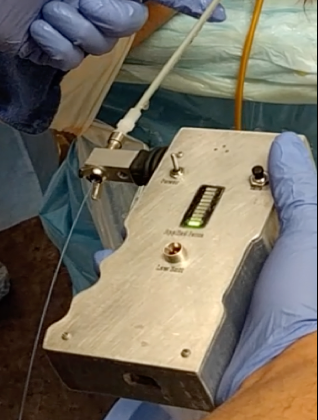The Ureteral access sheath Force Sensor (UAS-FS) (pictured below) was used to measure ureteral access sheath deployment force in 56 patients at UC Irvine. Tamsulosin (0.4 mg) was given for up to one week for the majority of patients. Continuous UAS-FS measurements were recorded from the urethral meatus to the renal pelvis.

He explained that based on data from a previous study done on adult pigs, 8 newtons of force were used as the upper limit. If a reading of 8N was reached by the force sensor during 16Fr ureteral access sheath deployment, the sheath was exchanged for a 14Fr; if 8N was again reached, then an 11Fr was used. At the end of each procedure, ureteral injury was assessed using the 0 to 5 post-ureteroscopic lesion scale.
Among 56 patients, there were 64 UAS deployments. The 16F UAS could be passed at less than 8N in 61% of patients. In each of the remaining cases, a 14F was passed in 18 cases and an 11F in the remaining cases. The mean post-ureteroscopic lesion scale grade was 0.76 with a range of 0-3.
Zachary concluded that the clinical force sensor reliably measured UAS insertion forces in a clinical setting. He added that despite routine passage of 16F UAS, an applied force of less than 8N resulted in a PULS score of 2 or less.
Presented by: Zachary Valley, Clinical Researcher from the University of California, Irvine (UCI)
Authors: Kamaljot S. Kaler, Mitchell O’Leary, Vinay Cooper, Zachary A Valley, Renai Yoon, Roshan M. Patel, Jaime Landman, Ralph V. Clayman.
Affiliation: University of California, Irvine
Written by: Renai Yoon, Department of Urology, University of California-Irvine, medical writer for UroToday.com at the 36th World Congress of Endourology (WCE) and SWL - September 20-23, 2018 Paris, France


